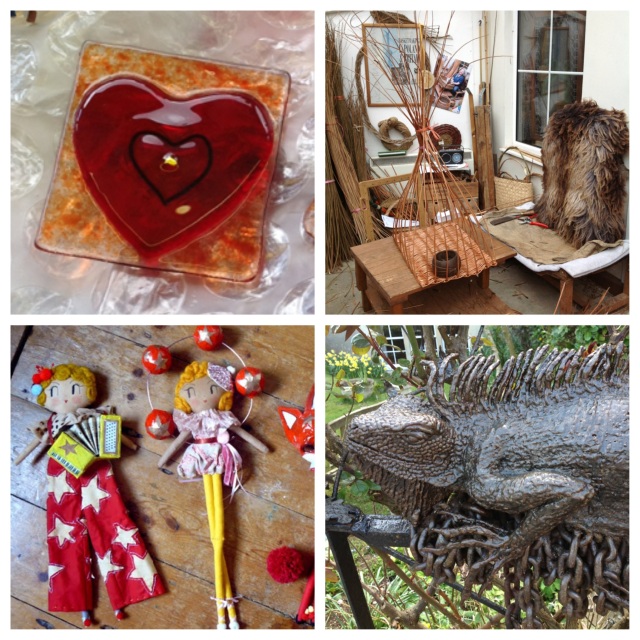Since my last update I’ve met up with a further four local makers. The first was fused glass artist (and carpenter) Kim Mylchreest who works from her garden studio to create bowls, plates, wall-art, jewellery, coasters, and anything else glassy you might be able to think of. We talked about the process of learning new skills and perfecting what you do, and making sure the materials are right at every stage. I never knew glass was so versatile and totally fell in love with some beautiful shiny glass called dichroic glass that looked a bit like iridescent fish scales. I also had the opportunity to meet with the basket maker Norah Kennedy in Stroud who told me all about the basket communities she’s become involved with all around the world and taught me loads about different types of basket-making using a wide variety of materials and techniques. Norah also does loads of teaching, and even taught Roy Youdale who I interviewed last year about his basket practice. Visiting Norah was much like visiting a basket museum with her vast collection of baskets from the world over and I was thrilled to be able to learn so much in just one visit.
My most recent interviews were with Sarah Burford and Julian Warren. Sarah is perhaps more widely known as Curious Pip and she makes handcrafted dolls using vintage fabrics and inspiration from 30s showgirls. Self-taught and working from home Sarah started out doing illustrations with the intention to make herself a little pocket money. Two years on and her dolls have become internationally collectable and always in high demand. We talked about the importance of the online community for contemporary makers and where her business might progress next. Sculptor Julian Warren of Metalgnu, on the other hand, has already been welding his creations for twenty years so it was great to hear the contrasts between someone just starting out and someone more established in their trade. Julian’s creations already adorn much of Bristol (in the Botanic Gardens, St Andrews Park, and on Whiteladies Road to name a few locations) and he showed me the latest work soon to be installed at the University. Julian’s sculpture fence is somewhat legendary in the area, and works as both something personal and a free shop-front.
Above top left to bottom right: Kim Mylchreest’s fused glass heart, Norah Kennedy’s basket-weaving studio, two of Sarah Burford’s dolls, and a sculpture by Julian Warren
It’s nice to have such a variety between the things people are making, whilst at the same time starting to draw out themes that run throughout. For instance, the importance of time is something that comes up a lot, not only in the sense of time taken to learn a craft, but in thinking about how much time goes into each piece, and the impossibility of accurately charging for time. Many creative practitioners, particularly those working from home, have stressed the difficulty of separating themselves from their work, thus making it difficult to define ‘work’ time from ‘free’ time. Following this, then, how does one price something that might have taken 14 hours of actually interacting with the final piece to make, but also had endless hours of mentally planning the work, and years of practice to hone specialist skills? Different makers I’ve spoken to have dealt with this in all sorts of ways and it’s been fascinating to learn about the intricacies of their businesses.
Something else that’s really run throughout each and every interview is the real passion people have for the things they make. An enthusiasm for skill, materials, tradition, and innovation has been at the foreground of our conversations, and there’s been a strong sense of community lying underneath as makers recommend other artists and craftspeople to talk to and visit that they might have worked with, trained under, or simply admired themselves.
To make a start on analysing these themes I’ve been using my new favourite technique – word clouds. By pasting the text you want to analyse into a programme such as wordle you can produce snazzy-looking visual representations which instantly highlight the key issues that came up when talking to someone. The bigger the words appear, the more often they were mentioned. For instance, here’s the word cloud that resulted from my conversation with Sarah last week:
As you’d expect, words such as ‘dolls’ and ‘fabric’ loom large, as this is what Sarah’s craft is based around. We can also pick out the themes most influential in her work – ‘vintage’, ’30s’, and ‘showgirls’ amongst others. I find it interesting that ‘things’ and ‘people’ are two of the largest words, indicating a stark bifurcation in thinking between maker and made which is at the heart of craft discourse. It is precisely this bifurcation that I’m interested in investigating, and potentially flattening out somewhat through drawing on theorists such as Jane Bennett and Bruno Latour. I’ll save that excitement for another blog post though, this one is plenty long enough as it is.




